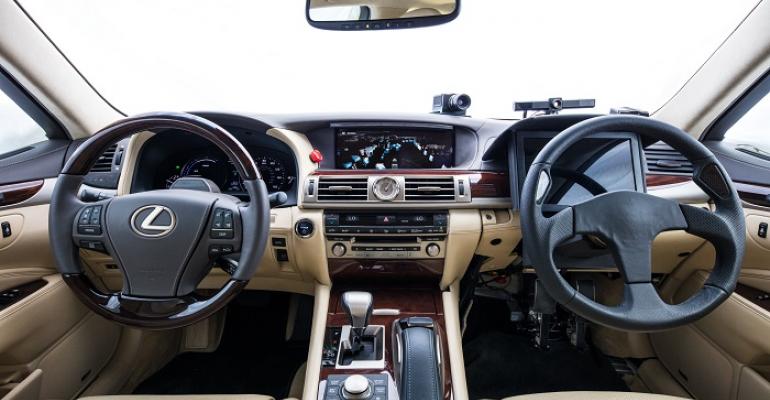Toyota says its latest autonomous research vehicle more accurately understands its surroundings and has improved object detection.
Toyota showed off its new Platform 2.1 technology, which also can better predict data such as road signs and lane markings to support map development, in a prior-generation Lexus LS on a closed course for the investor community this week.
“In the last few months, we have rapidly accelerated our pace in advancing Toyota’s automated driving capabilities,” Gill Pratt, CEO-Toyota Research Institute, says in a statement of the fast shift from Platform 2.0 unveiled this past March.
Platform 2.1 adds new suppliers to Toyota’s autonomous program, including Luminar for high-fidelity LiDAR. Luminar’s LiDAR has a longer sensing range and can better determine the positions of 3D objects, Toyota says. It also has a dynamically configurable field of view, “which means that the measurement points can be concentrated where sensing is needed the most,” the automaker says.
Toyota pairs the new LiDAR with its existing 360-degree sensing system.
A second driver cockpit on the passenger side is present in the Platform 2.1 research vehicle. Toyota says it has a fully operational drive-by-wire steering wheel and braking and acceleration pedals and is being done to determine the best approach to hand off driving from the vehicle to a human driver and vice versa.
Guardian and Chauffeur modes are being tested concurrently with the 2.1 vehicle in a single technology stack and using the same sensors. Toyota says this is the first time it has demonstrated Guardian (human driver in control, automated driving system intervention possible) and Chauffeur (SAE Level 4/5, all vehicle occupants are passengers) systems on the same platform.
Toyota says its Guardian system now can detect drowsy drivers in certain situations and, if there is no driver correction after warnings, automatically brake and steer the car to follow road curvature. Advancements to the Chauffeur system include the ability to navigate around obstacles in the road and “make a safe lane change around an impediment in its path with another vehicle traveling at the same speed in the lane next to it.”
TRI also reveals it has used artificial intelligence in a simulator to “detect a driver’s skeletal pose, head and gaze position and emotion to anticipate needs or potential driving impairments.” The latter category includes detecting a driver drinking a beverage, which would trigger an adjustment in air conditioning or rolling down the windows to cool him or her.
Toyota is targeting 2020 for launching vehicles with automated driving technology suitable for highway driving.
That is the same year it is due to demonstrate Level 4 automated technology at the Summer Olympics in Tokyo. However, Kiyotaka Ise, Toyota’s chief safety technology officer and senior managing officer, told WardsAuto in June the Level 4 vehicles will be for demonstration purposes only, not commercial application.





